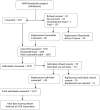Prevalence of anxiety, depression and post-traumatic stress disorder in the Kashmir Valley
- PMID: 29082026
- PMCID: PMC5654454
- DOI: 10.1136/bmjgh-2017-000419
Prevalence of anxiety, depression and post-traumatic stress disorder in the Kashmir Valley
Abstract
Background: Following the partition of India in 1947, the Kashmir Valley has been subject to continual political insecurity and ongoing conflict, the region remains highly militarised. We conducted a representative cross-sectional population-based survey of adults to estimate the prevalence and predictors of anxiety, depression and post-traumatic stress disorder (PTSD) in the 10 districts of the Kashmir Valley.
Methods: Between October and December 2015, we interviewed 5519 out of 5600 invited participants, ≥18 years of age, randomly sampled using a probability proportional to size cluster sampling design. We estimated the prevalence of a probable psychological disorder using the Hopkins Symptom Checklist (HSCL-25) and the Harvard Trauma Questionnaire (HTQ-16). Both screening instruments had been culturally adapted and translated. Data were weighted to account for the sampling design and multivariate logistic regression analysis was conducted to identify risk factors for developing symptoms of psychological distress.
Findings: The estimated prevalence of mental distress in adults in the Kashmir Valley was 45% (95% CI 42.6 to 47.0). We identified 41% (95% CI 39.2 to 43.4) of adults with probable depression, 26% (95% CI 23.8 to 27.5) with probable anxiety and 19% (95% CI 17.5 to 21.2) with probable PTSD. The three disorders were associated with the following characteristics: being female, over 55 years of age, having had no formal education, living in a rural area and being widowed/divorced or separated. A dose-response association was found between the number of traumatic events experienced or witnessed and all three mental disorders.
Interpretation: The implementation of mental health awareness programmes, interventions aimed at high risk groups and addressing trauma-related symptoms from all causes are needed in the Kashmir Valley.
Keywords: cross-sectional survey; health services research; public health.
Conflict of interest statement
Competing interests: None declared.
Figures
References
-
- World Federation for Mental Health. Dignity in mental health. Occaquan, Virginia: World Federation for Mental Health, 2015.
-
- Sixty-fifth World Health Assembly. The global burden of mental disorders and the need for a comprehensive, coordinated response from health and social sectors at the country level. Geneva: Switzerland, 2012.
LinkOut - more resources
Full Text Sources
Other Literature Sources
Medical

